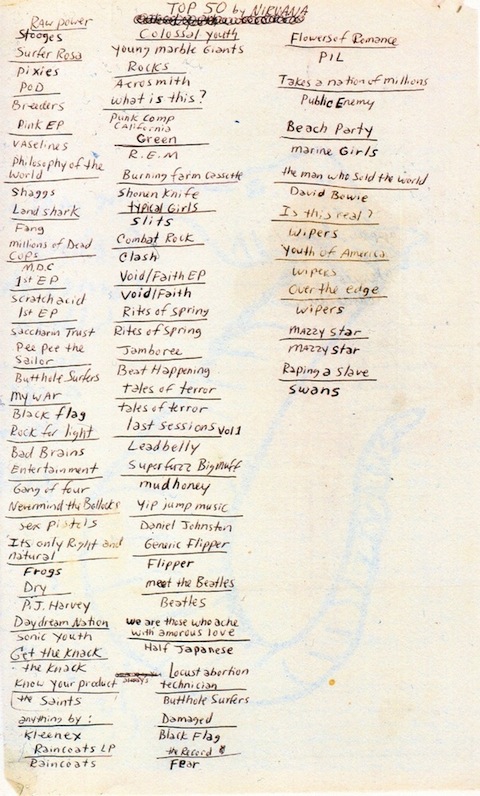
Several years ago, we featured a list Kurt Cobain made of his top 50 albums, which appeared in his journals, published in 2002. It’s mostly a typical list of standards one would find in any young punk’s record collection in the late 80s/90s. As we wrote then, his “‘Top 50 by Nirvana’… seems like the ideal code for producing a 90s alternative star.” But these sources were not widely accessible at the time. Cobain’s influence was such that he turned millions of people on to music they’d never heard before. That influence continues, of course, and you can partake of it yourself in the playlist below.
Amid the classic rock and classic punk—the Beatles, the Clash, the Sex Pistols—are a few slabs of classic DC hardcore, then and now pretty obscure. Dave Grohl—stalwart of the DC scene before Cobain recruited him to move across the country and join Nirvana—may have added these albums to the list, or Cobain might have done so himself. In any case, his mentions of them, and their posthumous appearance in his letters and notes, brought bands like long-defunct Faith and Void new recognition, as well as post-hardcore pioneers Rites of Spring, who helped inspire the emo and screamo to come, for better or worse.
Alongside Iggy Pop, Black Flag, and Bad Brains are lesser-known punk bands like the Raincoats, the Vaselines, and the Saints, playful lo-fi weirdos like Daniel Johnson, the Shaggs, and Half Japanese; the country blues of Lead Belly, caustic noise of Butthole Surfers, thunderous, punishing nihilism of Swans…. Cobain may have helped them all sell a few records, and he definitely inspired new bands that sound like them by turning people on to their music for the first time. (When Cobain covered David Bowie, however, fans started to mistake “The Man Who Sold the World” for a Nirvana song, to Bowie’s understandable consternation.)
Cobain’s list is limited to a fairly narrow range of styles, with some rare exceptions: Lead Belly, Public Enemy, Aerosmith (!)—it’s an almost purist punk and punk-derived palate, the DNA of Nirvana. In the age of the internet, one can cobble together a list like this—with no real prior knowledge—in an hour or so, simply by googling around and doing a bit of research. During Cobain’s formative years on the outskirts of Seattle, when a lot of this music circulated only on limited cassette runs and poorly recorded mixtapes and copies, on record labels financed by vegan bake sales and loans from the ‘rents—it could be very hard to come by.
While Cobain’s list may look, in hindsight, like standard fare to many longtime fans, what it represents for those who came of age musically in the years just before the Web is a physical journey through all of the relationships, concerts, and record shops one had to move through to discover the bands that spoke directly to you and your friends.
Related Content:
Kurt Cobain’s Home Demos: Early Versions of Nirvana Hits, and Never-Released Songs
Watch The Last 48 Hours of Kurt Cobain on the 20th Anniversary of the Musician’s Suicide
Josh Jones is a writer and musician based in Durham, NC. Follow him at @jdmagness


Leave a Reply